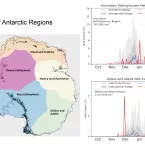Our Research
As climate changes, how do Earth's frozen areas affect our planet and impact society?
In this section
Related News & Stories
Filter by:

Spotlight
Welcome to the new NSIDC.org! Our website now offers an even more intuitive and efficient interface to allow users from all different backgrounds to discover and analyze over 1400 data sets and gain expert-verified knowledge about the cryosphere.

Feature Story
From 2020 to 2024, the Arctic Rain on Snow Study (AROSS) at the National Snow and Ice Data Center (NSIDC) hopes to quantify and better understand rain on snow and its impacts.

News Release
This fall, the University of Colorado (CU) Boulder will host a Greenland natural science data workshop to bring together members of the data and research community to share plans, discuss open opportunities and chart necessary developments in Greenland-focused data and tools to support the next decade of science in service to communities in Greenland and across the globe.
Analysis - Sea Ice Today
Arctic sea ice extent continued its summer decline. Extent is below average but not as low as in recent summers. In the Antarctic, sea ice extent is currently at record low levels for this time of year.
Analysis - Sea Ice Today
Both of Earth’s polar regions had low sea ice extent for the month of June, with Antarctic sea ice setting a record low. Arctic sea ice extent stands at tenth lowest.

Analysis - Ice Sheets Today
Seasonal surface melting in Greenland got off to a slow start in 2022. In Antarctica, several areas had an intense coastal surface melting pulse at the end of the summer.